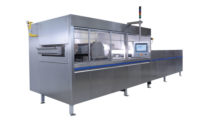
Luigi Girotto, general manager of engineering and maintenance for Azusa, Calif.-based Morris National, knew the company had a winner when it launched Nutffles in 2009. The truffles, which feature a whole roasted nut in a creamy chocolate nut filling covered with Belgian chocolate and crisped rice, have quickly become a favorite amongst chocolate lovers.
He also knew that producing these tasty morsels efficiently would be challenging. A key part of the production process involves enrobing, which involves applying the chocolate just right to ensure a visual delight for the consumer.
Typically, enrobing centers with chocolate doesn’t pose any problems for a positive displacement pump. Add an inclusion, however, such as crisped rice, and not all pumps are up to the challenge, as Girotto discovered.
“We noticed that when the chocolate was recirculated, the size of the crisped rice pieces was reduced in size by as much as 50%,” he says. “This was unacceptable from a product quality standpoint.”
Girotto and his team took steps to overcome the problem. They first tried accommodating the smaller end-product size by modifying their packaging line. The packaging machines are tolerant to 1/8-inch variations, but they were seeing variations of ¼ inch. They decided to package four smaller truffles instead of three to meet the package weight requirement.
Next, they changed the coating recipe.
“Over a certain amount of time, the consistency and integrity of the outside layer would change because the size of the crisped rice pieces would decrease,” he adds. “We had to increase the amount we added to the chocolate in order to maintain product consistency.”
Both of these steps weren’t viable long-term solutions and the company began looking for another pump that would keep the pieces intact and yet maintain the planned production volume. With the help of Bykowski Equipment & Engineering Co., Girotto decided to test a Waukesha Cherry-Burrell Universal I positive displacement pump.
“We sent SPX our product to test and they could do it,” Girotto recalls. “The size of the crisped rice pieces was maintained throughout the entire 35-minute cycle. That’s how low long it takes to fill the chocolate tank with inclusions, form the curtain and exhaust the batch. Plus, we’ve had no wear issues.”
Chocolate alone is a very abrasive product. Add crisped rice to it and one creates a very powerful grit that will wear contact surfaces. With the original pump, maintenance became a huge issue. Maintenance crews had to replace the scrapergate shuttles sometimes as often as twice a week to avoid concerns about product contamination.
Naturally, such ongoing maintenance proved costly. Besides the cost of the gates, the line had to be shut down for an hour, reducing overall output and efficiency.
Girotto reports that this downtime was eliminated when they switched to the Waukesha pump. Moreover, maintenance returned to being straightforward and manageable.
“We open it [the pump] up when we aren’t in production to clean it and inspect for wear, but we aren’t experiencing any,” he says. “At the end of the season, we’ll open it to clean it and possibly change the seals. I don’t anticipate any other maintenance issues except what’s recommended by the manufacturer and the inspections required by our Quality Control department. It is night and day from what we were experiencing two years ago with the gates. If I could go back with the knowledge I have now, I would have gone with the Waukesha pump for this particular application. There is no shear on the chocolate and the ease of maintenance is hands down.”
The Universal PD pump from SPX is designed with several long-life features including exclusive, non-galling alloy rotors that permit running at tighter clearances and pumping a wide variety of viscosities. And Girotto is convinced that the pump will work in his chocolate application for years to come.





